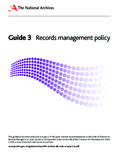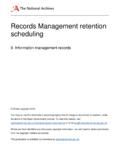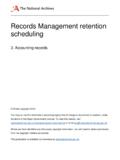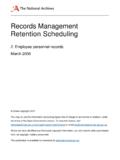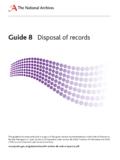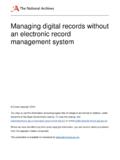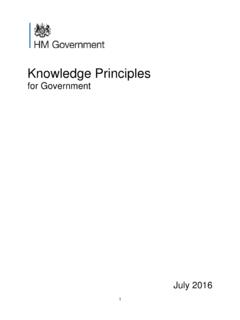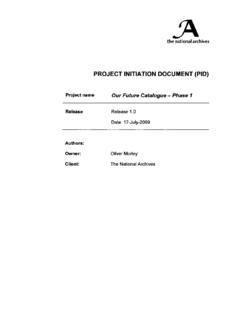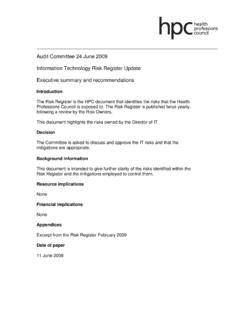Transcription of Records Management retention scheduling 1. …
1 Records Management retention scheduling 1. Buildings Records Crown copyright 2012. You may re-use this information (excluding logos) free of charge in any format or medium, under the terms of the Open Government Licence. To view this licence, visit or email Where we have identified any third-party copyright information, you will need to obtain permission from the copyright holders concerned. This publication is available for download at Records Management retention scheduling 1. Buildings Records Contents 1 Introduction .. 2. 2 Background .. 3. 3 Aims and objectives .. 3. 4 Types of Records .. 4. 5 Records 5. 6 Records storage .. 6. 7 Disposal schedules .. 6. 8 Reviewing Records .. 7. 9 building Records Centre (BRC) .. 8. 10 Further information .. 11. Appendix: Model Disposal 12. 1 Introduction This guide is intended to supplement the general guidance on Records Management provided by The National Archives Information Management and Practice Department.
2 This guidance forms part of a series on retention scheduling published by The National Archives. A revision of guidance first published by the Public record Office (PRO) in June 1996, it was prepared by the PRO and the Conservation Unit of English Heritage. While the criteria used are particularly relevant for historic buildings, the guidance covers all buildings on the Government Estate. All Records of construction and works processes, including plans and drawings, of government buildings are public Records within the meaning of the Public Records Act 1958. Where Records are created by a private contractor in fulfilment of a contract that has been let by a government department or agency, these are also public Records excepting those Records relating to the internal administration of the contractor, for example personnel and wages Records .
3 Last updated June 2004 Page 2 of 20. Records Management retention scheduling 1. Buildings Records 2 Background In the past on the Civil Estate the majority of buildings Records were created as a result of contracts let by the Property Services Agency (PSA) and its predecessors. These were deposited with the Department of the Environment, Transport and the Regions and stored at their Records centre in Oxfordshire. They are appraised when their administrative value has elapsed (usually 16 years after the end of the contract). Records relating to buildings on the Defence Estate have been deposited with the Ministry of Defence. Since the privatisation of PSA, buildings contracts have been let by the government departments and agencies themselves. Many of the responsibilities previously exercised by Property Holdings have also been assumed by departments, following the setting up of the Property Advisers to the Civil Estate (PACE).
4 The Records generated will become the responsibility of those departments and should be included in their appraisal programmes. Some departments may also have buildings Records dating from the mid-1980s (before PSA privatisation) when they became untied' from PSA. and were able to let their own contracts for building works. 3 Aims and objectives The primary purpose of this guidance is to outline the methods by which building Records can be maintained in a readily accessible form to ensure simple, economic and efficient use. The long term practical value of building Records sets them apart from other types of Records . Whereas other Records may be administratively useful for 10-20 years, some building Records will be required for as long as the buildings exist. This can be hundreds of years. building Records have not only historic but also great practical value.
5 Much time and money can be wasted searching for or recreating relevant important information such as construction details, wiring and plumbing services, and colour schemes. Effective Management of original material can avoid this. Last updated June 2004 Page 3 of 20. Records Management retention scheduling 1. Buildings Records A full record of a building 's structure, plant and services is essential in order to plan accurately for its future care and to enable departments to fulfil their legal obligations and liabilities. The maintenance of Records is also essential to ensure that departments retain the evidence necessary to develop effective defences against unwarranted claims. To ensure that buildings are cared for efficiently, economically and to the appropriate standards it is essential that appropriate Records are maintained throughout a building 's life.
6 The development of comprehensive collections of Records is fundamental to the well-being of all buildings. The government is committed to setting the highest possible standards in the care of its historic buildings estate. Departments entrusted with the upkeep of these historic buildings are required to look after them expertly and sensitively. This commitment was set out in the Environmental White Paper This Common Inheritance (Cm 1200, 1990). 4 Types of Records Essentially government building Records divide into three broad types: Legal Documents which include estate title, leasehold and other contract documentation relating to the building and its surrounding land Policy Records which include surveys, evaluation reports and policy studies Administrative Records which are particularly relevant to the maintenance, repair and reconstruction of buildings.
7 They comprise information such as survey drawings, as built' drawings and Records of services, historical narratives and descriptions, photographs, maintenance Records , inventories of plant, equipment and furnishings, and possibly archaeological information about the site and building Last updated June 2004 Page 4 of 20. Records Management retention scheduling 1. Buildings Records 5 Records creation Document classification It is essential to consider the potential long term value of documents at the time they are created. Time spent identifying and classifying Records at this stage will reap benefits in the long term. For example, it will enable the later process of appraisal to be accomplished efficiently and without the need to examine numerous files and papers in order to eliminate valueless Records . The most effective way of achieving this aim is to compile a disposal schedule which lists and describes all buildings Records and assigns retention periods to them.
8 See Disposal scheduling for more information. The model schedule appended to this guidance has been designed to help clarify the value of Records being created. Clearly mark Records to be retained as part of the building Records Centre (BRC) as such (see section 9). If the building is also a listed historic building or scheduled ancient monument, mark this clearly on the files and other papers. Records status Copyright in documents created in government departments is vested in the Comptroller of Her Majesty's Stationery Office (HMSO) at The National Archives on behalf of the Crown. Statutory provisions are covered by the Copyright, Designs and Patents Act 1988. Title deeds are not public Records within the meaning of the Public Records Act 1958 but nonetheless they will form an important element of the building Records Centre (see section 9).
9 Take due regard of a department's security needs in respect of buildings Records and seek the advice of Departmental Security Officers. Take particular care in relation to Records of buildings with a high security rating which are being managed in whole or in part by agents. Last updated June 2004 Page 5 of 20. Records Management retention scheduling 1. Buildings Records Departments contracting out projects and/or maintenance services to agents must ensure that the contracts contain clauses requiring the effective Management of Records , including the transfer of files and other Records to the department at the termination of any contract. In addition there must be adequate supervision of the Records created by the agents. At the end of a project or maintenance contract the Records must be transferred to the Departmental record Officer (DRO) who will arrange for their appraisal in accordance with current disposal schedules or other review system prevailing in the department.
10 6 Records storage Different patterns of Records usage require different forms of storage. Cost will be a factor but Records that need to be kept long term, such as those earmarked for the building Records Centre (BRC), should be kept within certain temperature and relative humidity limits. Those recommended for paper Records are: temperature 13 C to 18 C. relative humidity 45% to 65%. For electronic Records the recommendations are: temperature 18 C to 24 C. relative humidity 45% to 55%. 7 Disposal schedules As far as possible all government buildings Records should be included on a disposal schedule. This should indicate Records that are to be: destroyed after a specified period kept for First Review reviewed after a specified period (after the normal First Review period but before Second Review). Last updated June 2004 Page 6 of 20.

